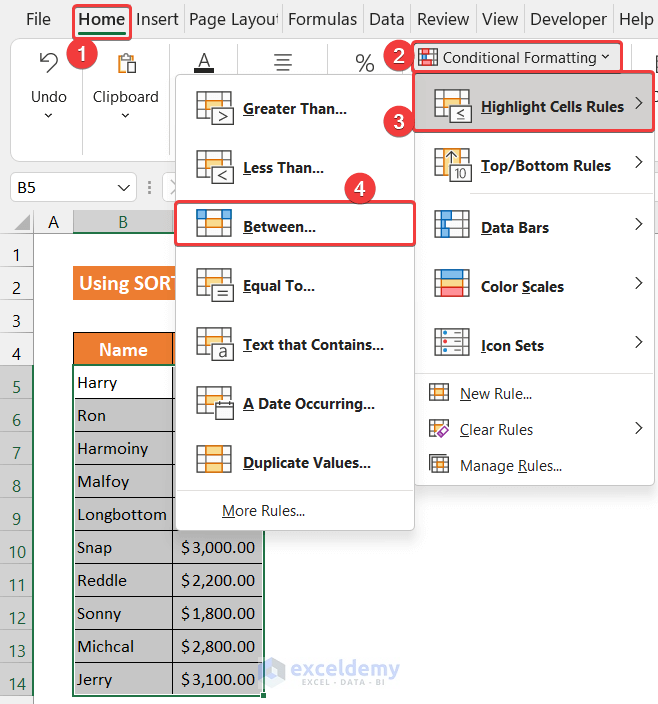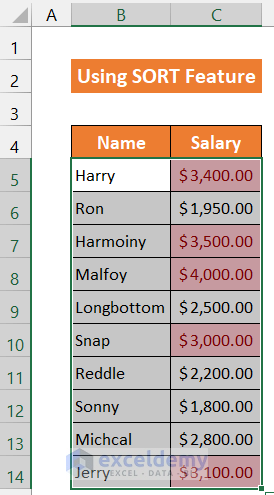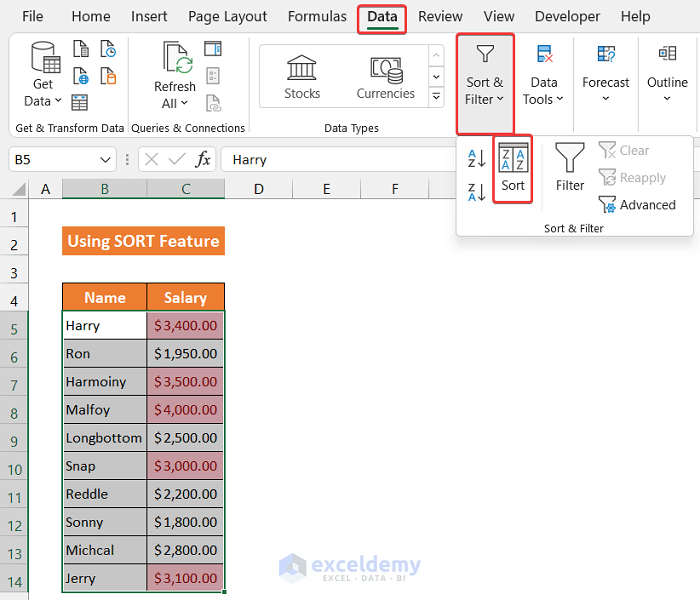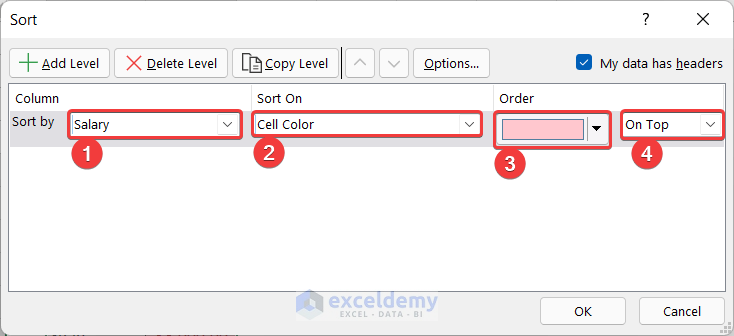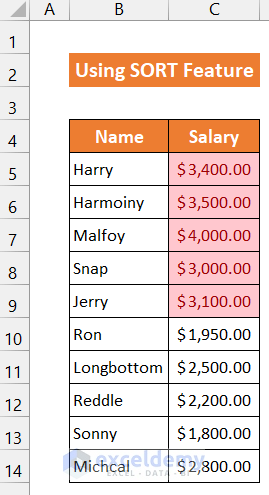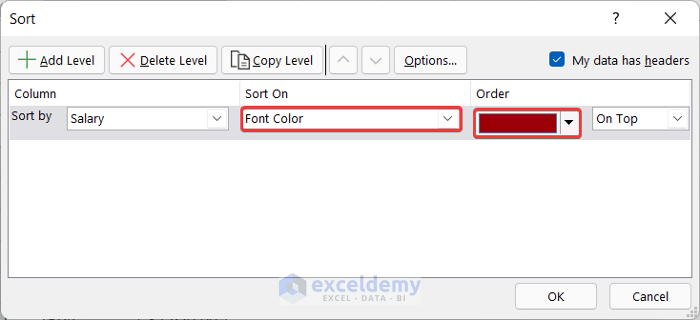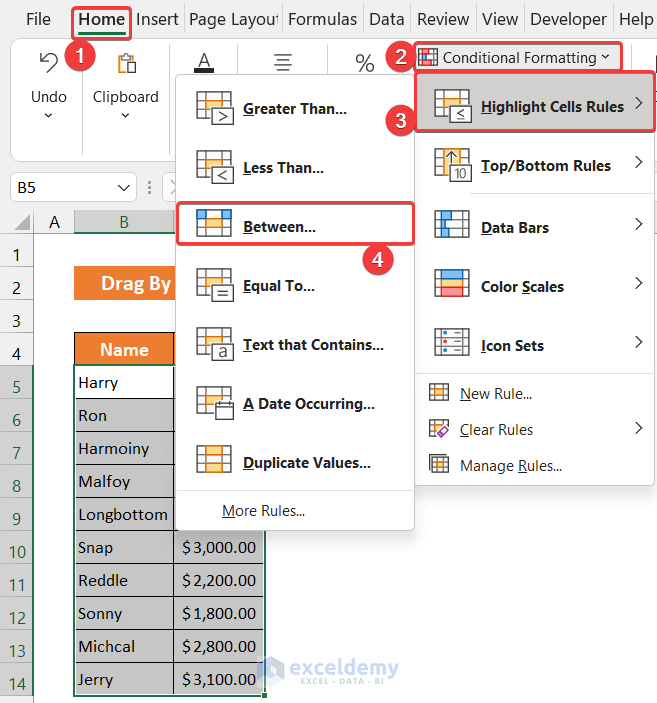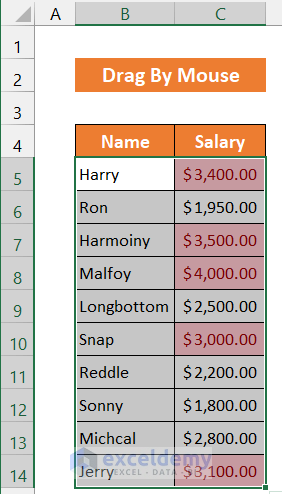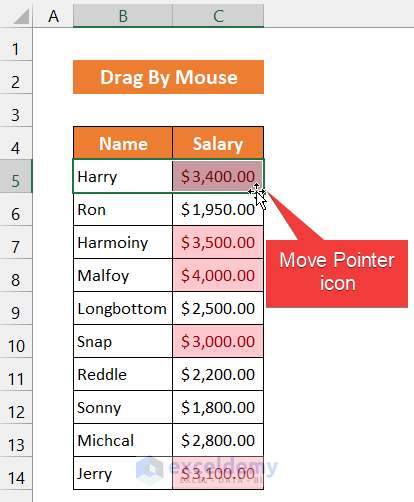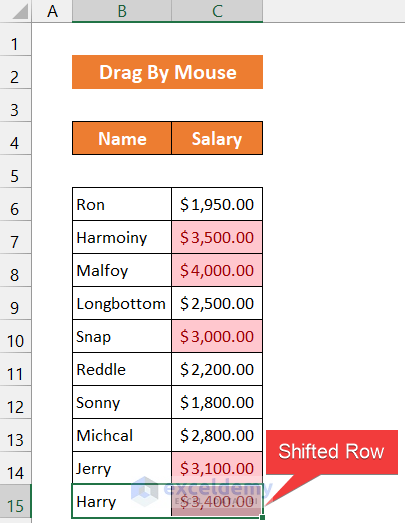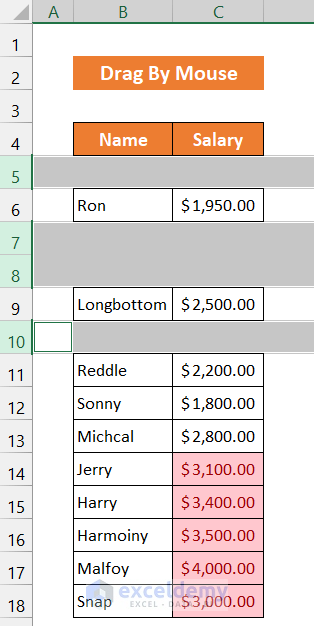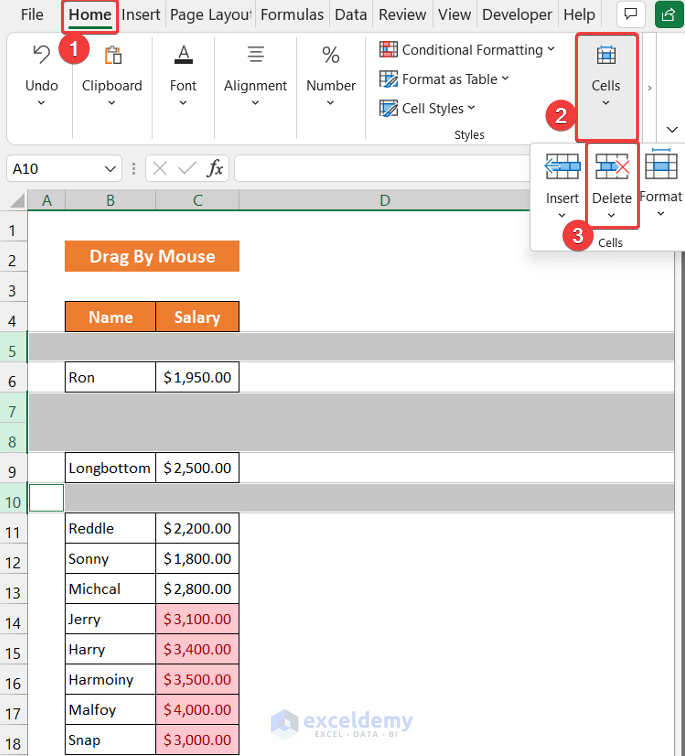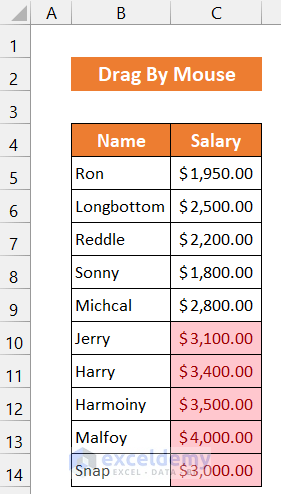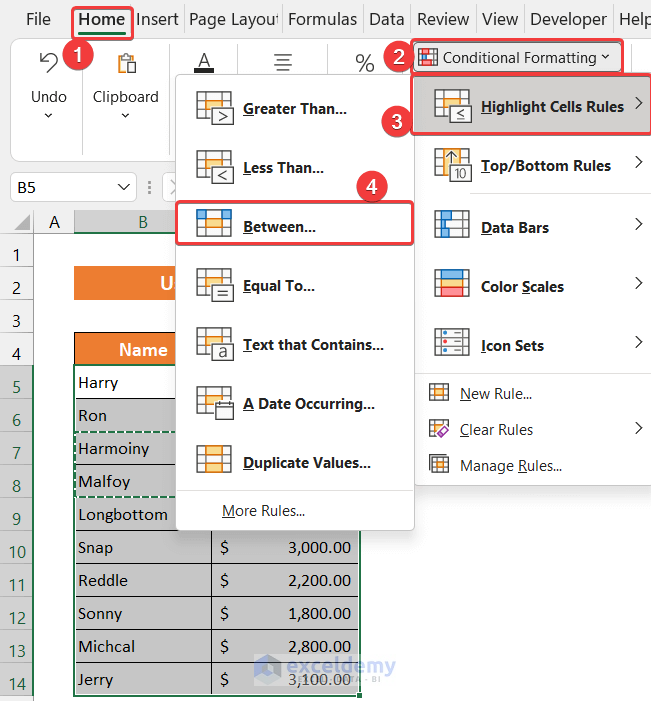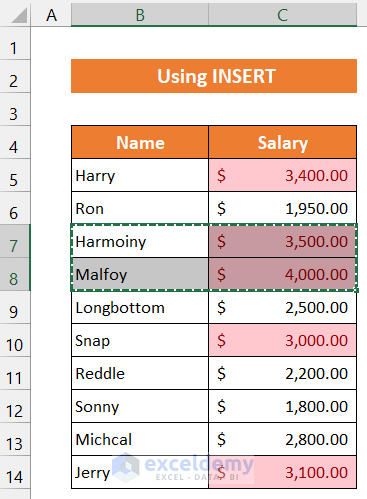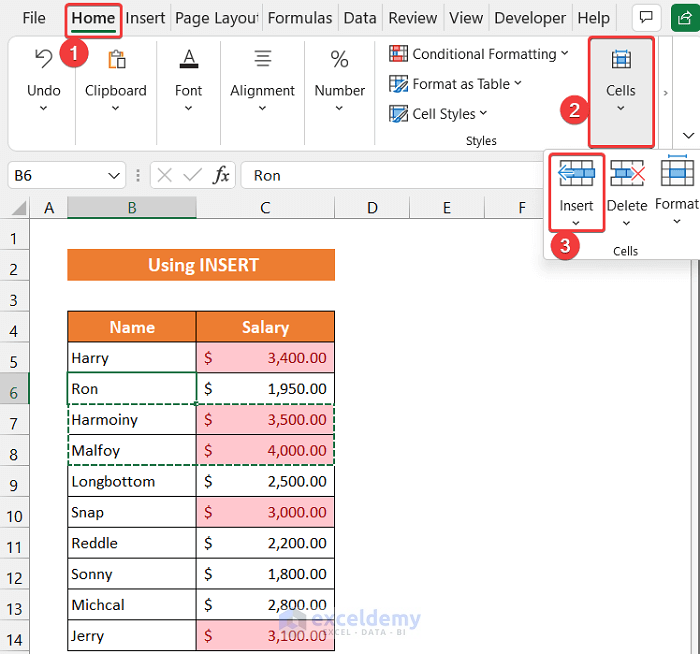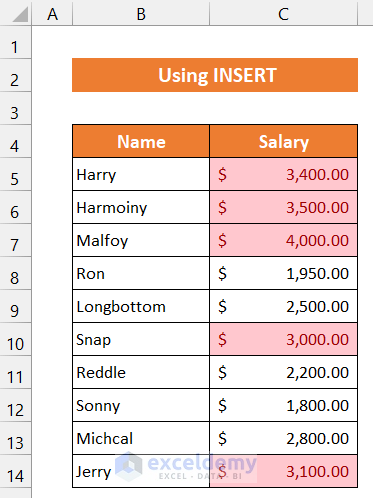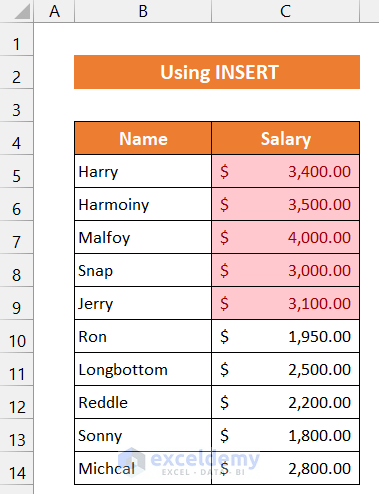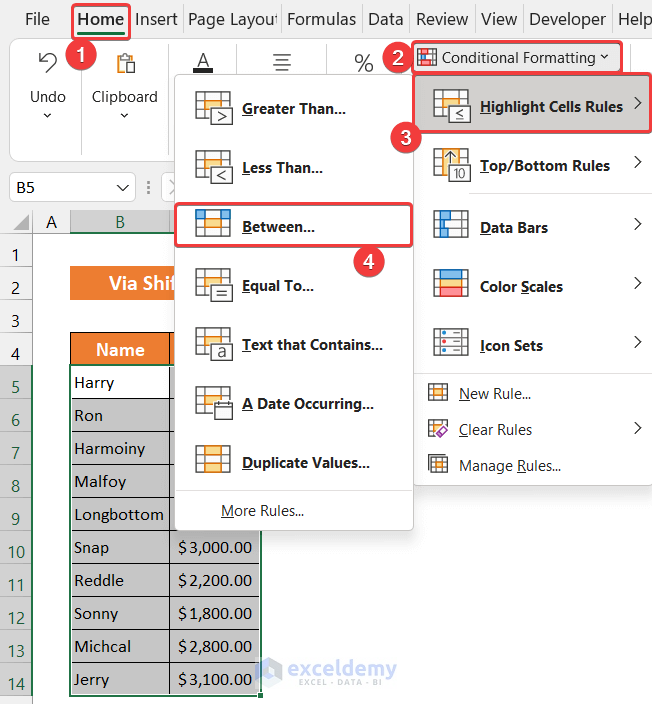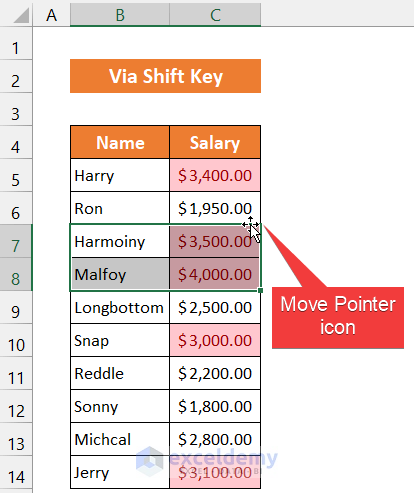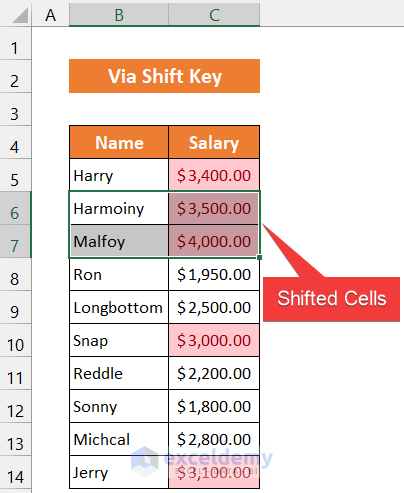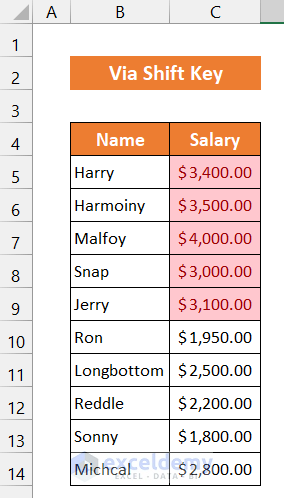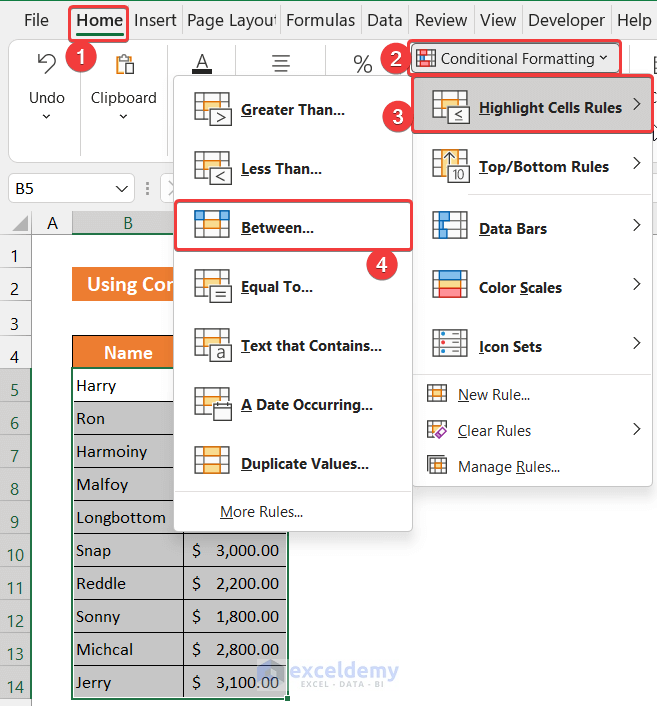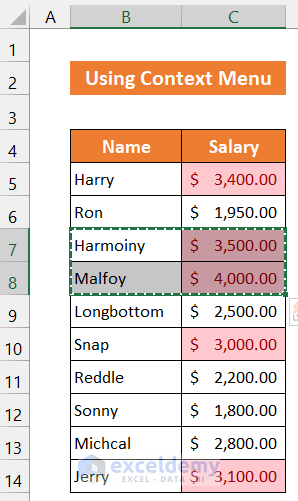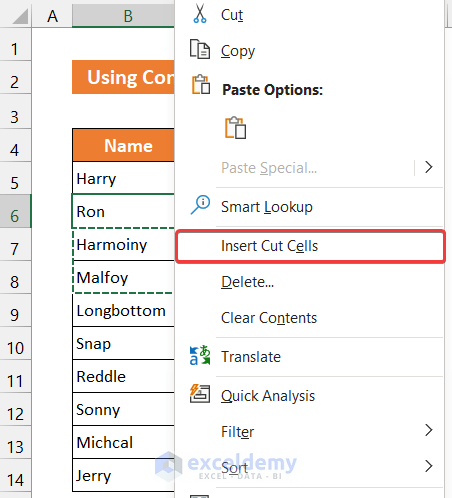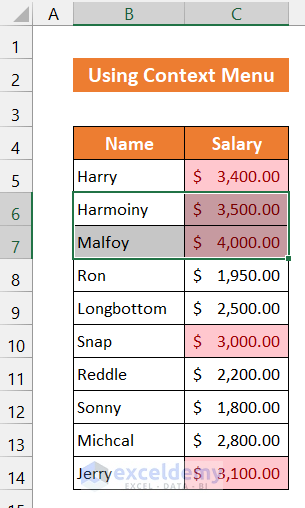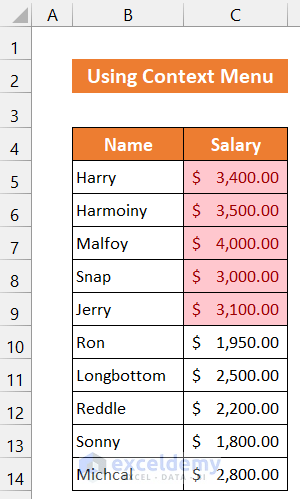While we work on a large Excel spreadsheet, we have to move highlighted cells to the top or bottom. Excel has amazing features to move its highlighted cells. If you are facing any problems doing it, this article might help you. In this article, we will demonstrate to you 5 possible approaches on how to move highlighted cells in Excel.
How to Move Highlighted Cells in Excel: 5 Easy Methods
To explain the procedures, we are considering the data of 10 employees of a company. Their name and salary are in columns B and C, entitled as Name and Salary respectively. So, our dataset is in the range of cells B5:C14. First, we will highlight the entities that are in the Salary range between $3,000 and $4,000. Then, we will move them to the top or bottom of our dataset using the following methods.
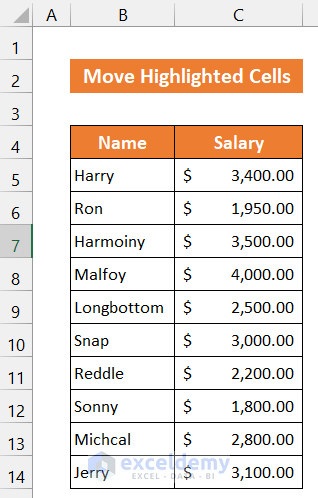
1. Use of Sort Command to Move Highlighted Cells
In this process, we will use a built-in feature of Excel, called Sort to move highlighted cells of our dataset. Our dataset is in the range of cells B5:C14. We will highlight the entities that are in the Salary range between $3,000 and $4,000 The steps of this method are given below:
Steps:
- First of all, select the entire range of cells B4:C14.
- Now, in the Home tab, select Conditional Formatting. After that, click on Highlight Cell Rules > Between.
- A small dialog box, called Between will appear.
- Then, write down your desired lowest and highest salary amount like the image shown below. Here, we choose the salary range of $3,000 to $4,000.
- After that, choose the cell highlight pattern, We kept the default one, Light Red Fill with Dark Red Text.
- Click OK to close the dialog box.
- You will see the salaries within the range are highlighted.
- Now, in the Data tab, select the Sort & Filter group. Click on Sort.
- A small dialog box, called Sort will appear.
- In this dialog box, click on the drop-down arrow of the Column option and choose the Salary.
- Then, change the Sort On option from Cell Values to Cell Color.
- Click on the drop-down arrow of the Order option and choose the cell color.
- Besides the Order column, there is another untitled column. Click on it and you will get 2 options. On Top/On Bottom. Choose anyone according to your desire. Here, we kept the On Top option.
- Finally, click OK.
- You will find all the highlighted rows move upward.
In the end, we can say our method worked successfully and we are able to move the highlighted cells.
Things You Should Know
As our highlight pattern contains both the cell color and font color, you can also choose the Sort On option with Font Color. The result of both selections will be the same.
Read More: How to Move a Group of Cells in Excel
2. Drag Highlighted Cells to Move
In this approach, first, we highlighted the salaries within the range of $3,000 to $4,000. Then, we will drag the highlighted rows at the bottom of our dataset through our mouse. Our dataset is in the range of cells B4:C14. The process is given below:
Steps:
- First, select the entire range of cells B4:C14.
- Now, in the Home tab, select Conditional Formatting. After that, click on Highlight Cell Rules > Between.
- A small dialog box, called Between will appear.
- In this dialog box, write down your desired lowest and highest salary amount like the image shown below. We chose the salary range of $3,000 to $4,000.
- Then, choose the cell highlight pattern, We kept the default one, Light Red Fill with Dark Red Text.
- Click OK to close the dialog box.
- You will see the salaries within the range are highlighted.
- After that, select any of those highlighted cells with your mouse.
- As your mouse cursor will come near the bottom side of the cell, you will see a Move Pointer icon will appear.
- Now, select the Move Pointer icon and drag it to the bottom of the dataset with your mouse.
- You will see the row allocated at the bottom of the dataset.
- Similarly, do the same tasks for all of the highlighted cells.
- When you drag the rows through your mouse, an empty row will be created at that position. Now, select all of those empty rows.
- Next, in the Home tab, go to the Cells group and click Delete.
- Finally, you will get all the highlighted cells at the bottom of your dataset.
Thus, we can say that our procedure worked perfectly and we are able to move the highlighted cells.
3. Move Highlighted Cells Using Insert Option
In this method, we will first highlight the salaries within the range of $3,000 to $4,000. Then, we move the highlighted rows at the top of our dataset using the Excel Insert option. Our dataset is in the range of cells B4:C14. The steps of this procedure are given as follows:
Steps:
- In the beginning, select the entire range of cells B4:C14.
- Now, in the Home tab, select Conditional Formatting. After that, click on Highlight Cell Rules > Between.
- A small dialog box, called Between will appear.
- Then, write down your desired lowest and highest salary amount like the image shown below. Here, we choose the salary range of $3,000 to $4,000.
- Next, choose the cell highlight pattern, We kept the default one, Light Red Fill with Dark Red Text.
- Click OK to close the dialog box.
- You will see the salaries within the range are highlighted.
- Now, select the range of cells B7:C8.
- Press ‘Ctrl+X’ on your keyboard.
- Select cell B6 and in the Home tab, select Insert from the Cells group.
- You will see the range of cells will move upward.
- Similarly, follow the same procedure for the rest range of cells B10:C10 and B14:C14.
- Finally, you will get all the highlighted cells at the top of your dataset.
At last, we can say that our approach worked effectively and we are able to move the highlighted cells at the top of our dataset.
4. Using ‘Shift’ Key to Move Cells
In this case, we have to first highlight the salaries within the range of $3,000 to $4,000. Then, we move the highlighted rows with the help of the ‘Shift’ key of our keyboard and our mouse. Our dataset is in the range of cells B4:C14. The method is described below step by step:
Steps:
- At first, select the entire range of cells B4:C14.
- Now, in the Home tab, select Conditional Formatting. After that, click on Highlight Cell Rules > Between.
- A small dialog box, called Between will appear.
- After that, write down your desired lowest and highest salary amount like the image shown below. We chose the salary range of $3,000 to $4,000.
- Choose the cell highlight pattern, We left the default one, Light Red Fill with Dark Red Text.
- Then, click OK to close the dialog box.
- You will see the salaries within the range are highlighted.
- Now, select the range of cells B7:C8.
- Then, press the ‘Shift’ key and drag the cells Move Pointer icon through your mouse.
- The range of cells will move upward.
- Similarly, follow the same procedure for the rest range of cells B10:C10 and B14:C14.
- Finally, you will get all the highlighted cells at the top of your dataset.
At last, we can say that our working method worked effectively and we are able to move the highlighted cells at the top of our dataset.
Read More: How to Move Cells with Keyboard in Excel
5. Utilizing Context Menu
In this method, first, we are going to highlight the salaries within the range of $3,000 to $4,000. Then, we will move the highlighted rows with the help of the Cut command of Excel’s Context Menu. Our dataset is in the range of cells B4:C14. The method is explained below:
Steps:
- In the starting, select the entire range of cells B4:C14.
- Now, in the Home tab, select Conditional Formatting. After that, click on Highlight Cell Rules > Between.
- A small dialog box, called Between will appear.
- Then, write down your desired lowest and highest salary amount like the image shown below. Here, we choose the salary range of $3,000 to $4,000.
- After that, choose the cell highlight pattern, We kept the default one, Light Red Fill with Dark Red Text.
- Lastly, click OK to close the dialog box.
- You will see the salaries within the range are highlighted.
- Now, select the range of cells B7:C8.
- Press ‘Ctrl+X’ on your keyboard.
- Select cell B6.
- Right-click on your mouse and select the Inset Cut Cells option.
- The range of cells will move upward.
- Similarly, do the same job for the rest range of cells B10:C10 and B14:C14.
- Finally, you will get all the highlighted cells at the top of your dataset.
lastly, we can say that our method worked perfectly and we are able to move the highlighted cells at the top of our dataset.
Things You Should Know
If you have only a limited amount of highlighted cells to move, like our dataset, you can follow the manual approaches. Otherwise, we recommend you follow our first method. It will save you time.
Download Practice Workbook
Download this practice workbook for practice while you are reading this article.
Conclusion
That’s the end of this article. I hope that this will be helpful for you and you will be able to move highlighted cells in an Excel worksheet. If you have any further queries or recommendations, please share them with us in the comments section below.
Related Articles
- How to Move Cells in Excel with Arrow Keys
- How to Move Filtered Cells in Excel
- How to Move Cells without Replacing in Excel
- How to Use the Arrows to Move Screen Not Cell in Excel
- Move and Size with Cells in Excel
- [Fixed!] Unable to Move Cells in Excel
- How to Make Excel Move Automatically to the Next Cell
<< Go Back to Move Cells | Excel Cells | Learn Excel
Get FREE Advanced Excel Exercises with Solutions!